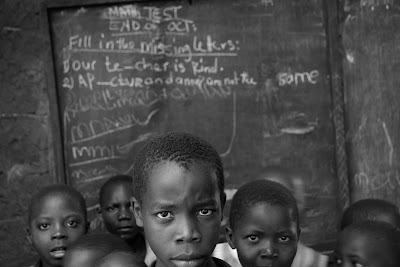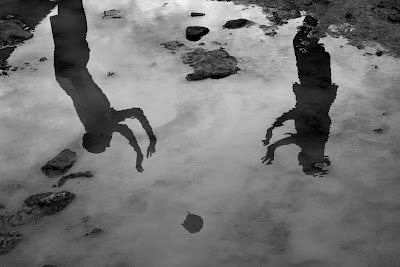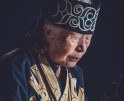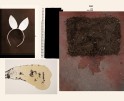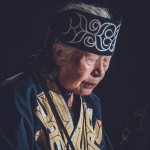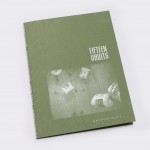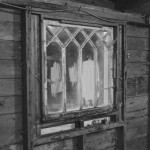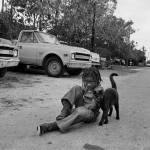Success Stories: Gloria Baker Feinstein
From where I’m sitting in my office, I can look to the left and see a large, luscious silver gelatin print of this image:
I think it perfectly describes Gloria Baker Feinstein. She’s always poking her fingers into new territory, capturing the fragility and beauty in our humanness. But it’s a gentle poke, and a touch that has changed the lives of many. Without a doubt, Gloria is a Success Story. I’ve written about her several times on Lenscratch, and supported her cause through my efforts on Collect.Give. I am proud to call her a friend and an inspiration. We have much to learn from her ability to effect change through photography. I first met Gloria at Review Santa Fe, many moons ago, but I was already familiar with her work through SHOTS Magazine. She was generous and inclusive from the moment I met her, and that hasn’t changed a bit.
Gloria lives in Kansas City, Missouri. She received an B.A. in Communication Arts and an M.A. in Photography and Graphic Design at the University of Wisconsin, at Madison. Along with raising a family and working on her photography, Gloria opened The Baker Gallery which featured legendary photographers. Her own work has been widely exhibited and published and is held in many collections.
After attending an NGO Workshop in Africa several years ago, she came home to create an amazing organization,Change The Truth, that benefits orphans in Uganda. She has not only changed the lives of her “children”, but changed all those who are part of the organization. It is truly a remarkable achievement.
INTERVIEW
You have always been a success in my eyes—I’ve loved your work since I first saw it in my SHOTS over a decade ago and have been so proud of all that you have accomplished with photography. Let’s start at the beginning and understand about how you moved from being a gallerist to a full time photographer.
The coolest part about having a photography gallery was getting up close and personal with work that had always inspired me. During the 80’s it was not a big deal to call Aaron Siskind or Helen Levitt and say, “Hi, I’m Gloria from the Baker Gallery and I’d like to do a show of your work. Could you send me twenty prints or so?” I exhibited the work I loved, and I was privileged to meet many of the photographers who made it. There was nothing quite as heavenly as spending the day with stacks of prints by Cartier-Bresson, Doisneau, Kertesz and Arbus – and turning my clientele onto them. Eventually, I got antsy, though. I wanted to go back to making my own work. As a mom and businesswoman, it had been impossible to find time to do serious image making. So I closed up shop and in 1995 dug my beloved old Hasselblad out of the drawer where it had been collecting dust for fifteen years. It still purred and was very happy to be cranked up again; I started shooting, and I’ve never looked back.
Your early work explores family and places that are familiar, what compelled you to take an NGO workshop in Africa?
I explored what was close at hand: my family, my children and their friends, neighbors, people I met on my travels. Before long I started doing pro bono work for non-profits in my hometown of Kansas City. I was also traveling quite a bit, taking workshops and shooting for various self-assigned projects. It occurred to me that I might want to learn how to shoot for and work with NGO’s abroad. I’d always wanted to go Africa, so I signed up for Thatcher Cook’s workshop in Uganda. It was offered by Maine Media Workshops for photographers who wanted to work with NGOs and learn how to cover world relief crises. I had to pick a project and research it before I went; I decided to photograph children at AIDS orphanages, and that is how I spent my three weeks in Uganda. I went to Africa with absolutely no intention of starting my own NGO, but that is exactly what happened. There was this one orphanage that got under my skin. The children there took up residence in my heart. When I returned home, I realized I couldn’t just print the pictures I’d made and stick them in a nice portfolio case. There was much more important work that needed to be done.
Can you share your thoughts in creating Change The Truth? Did it seem daunting?
It hit me one sleepless night shortly after I got home. I was lying there in the dark, jet-lagged, singing one of the lines from a song the kids had sung to me while I was at the orphanage: “We cannot change the truth, we can only say welcome.” I hummed it again and again until I realized that – at the very least – the truth about their food, education and medical care really could be changed! They just needed the proper assistance and ongoing support. I began calling family and friends, asking for $50 here, $100 there. In three months I had enough interest and support that I found myself filling out paperwork to become an official not-for-profit organization. Did it seem daunting? I didn’t really think about it. Something bigger was in the driver’s seat at that point. Honestly, had I known what I was getting into, I would have been terrified and probably would have run in the other direction! Now that interest in and support of CTT has grown from family and friends to an international level, though, I feel so proud of what has been accomplished. When I began, we were able to send only a few kids to school. Now we provide sponsorships for over thirty children, including kids in vocational school and university. Last May, one of our students graduated first in his class from nursing school! We send a healthy monthly stipend for food and medical care. Each December, I am amazed when a group of volunteers make the sacrifice of time and money to go to the orphanage with me. They teach – among other things – yoga, photography, karate, computer and music. We’ve helped put in gardens and rain water collection tanks. We’ve painted dormitories and provided new mattresses, blankets and mosquito netting. I get to see each year how the children’s’ lives really have improved. It’s unbelievably gratifying.
How has establishing and continuing Change the Truth made you think about photography? Has it changed the way you work?
I guess the biggest change is that I see photography more as a tool to educate and empower, rather than something I simply do for my own pleasure. There is a way to merge the two approaches, and that’s what I think is finally happening for me. I see my work as a way to give voice to those who have none. These children feel important when we collaborate on a photograph; they have a real sense of pride knowing that people in the US will see their pictures and know who they are. Some of these children had never even seen photographs of themselves when I arrived in 2006. I know now that the images I make are powerful reminders to the children that they exist, they are worthwhile and their stories deserve to be seen and heard.
I love the sensibilty that you bring to the photographs you create in Africa. There is not a whiff of travel photography-ness in the work—they are so genuine and often joyful. I imagine that being deeply connected to a community has allowed for that?
The children call me “Mama Gloria”. They are my kids. As you know, Aline, photographing your own kids is an intimate, genuine and reflective experience.
Can you also talk a little bit about your new work from your most recent trip to Uganda?
Each year I go, I try to do something a little different with my work. This year I moved outside the walls of the orphanage to photograph people living in the neighboring villages, people who are extensions of the orphans themselves. That, plus the fact that I had a new camera in tow, led me to create an entirely different body of images. And, yikes! they are in color.
You continue to make interesting new work in Kansas City too. How do you balance what you shoot?
If you’ve ever been with me on a walk, you know that sometimes I fall down. I’m always busy looking around, so sometimes I forget to look down at where I’m going. I could look around and shoot 24 hours a day. I’ve been photographing since I was a little girl (three years old!) with a Rocket Brownie camera strapped around my wrist. A couple days ago, I was driving home from my studio and saw an unbelievably thick mass of birds flying in patterns in the sky. I pulled over to the curb, jumped out and started shooting with my iPhone. Bird shit was dropping on me, but I was too mesmerized to move. Those particular shots may not be great or important pictures, but the experience of standing there underneath those birds, framing them this way and that, seeing something brand new every second, was absolutely exhilarating. I know for certain that as a kid there was not always film in that Rocket Brownie camera. It was the experience of looking at my world through the viewfinder, framing things just so, being able to fully consider one thing or another and feeling as if I was preserving those things in my own mind forever that made me fall in love with photography. In that sense, nothing has really changed. So I don’t think it’s as much of a balancing act as it is just a continuous flow of looking and shooting.
What are your thoughts about the marketing and promoting of your work in today’s photographic waters?
Ugh.
I hate that part of it. My kids can tell you I always said I was going to “famous by 50″. It’s true: I used to want to become a famous photographer. Now it doesn’t matter so much (OK, well it does a little). That’s a good thing, because I don’t think I’d be very motivated to work if I needed the recognition to do so. I do send in my work for the occasional juried show or prize, I do attend reviews now and then, and I am always thinking about the next book I’d like to publish. I love blogging because it’s a great way for me to share my new work with those who are interested. (I have to bite the bullet when I see that my work that has been lifted from my blog or website and used somewhere else, but I guess that’s the nature of the digital age.) The simpler and smaller I make my world of photography, the more time I have to just do it. Now that I’m an older and wiser woman, I can say that making the work is far more important that becoming famous for it. But I do have to admit that when you said I was going to part of the “success stories” on Lenscratch, my chest did puff out for the day, and I felt pretty darn smug.
What took your work to the next level?
Keeping at it. Getting more scrapes on my knees. Sharing my work with other photographers. Getting older.
What thoughts or advice do you have for emerging photographers?
Shoot every day. Keep your camera by the front door, and take it with you even if you’re just going to walk the dog. Look at all the work you can get your eyes on. Trust yourself. Don’t be afraid to ask others for help. Understand that you might have to do something else for money (I do commissioned portraits of children and families) and don’t feel embarrassed about it.
What cameras do you work with?
Canon 5D Mark II, iPhone, Diana, Hasselblad.
And finally, what would be your perfect day?
Officing from bed til noon. Reading “Go Dog Go” and other great books to my grandson Henry. Shooting whatever I want all afternoon. Processing what I shot. Margarita with sugar on the rim for happy hour. Out to dinner and a movie with my husband Eddie. Online scrabble til I can’t keep my eyes open any longer.
Thank you Gloria!
If you are interested in donating to Change The Truth, go here!
Posts on Lenscratch may not be reproduced without the permission of the Lenscratch staff and the photographer.
Recommended
-
Earth Week: Simon Norfolk: When I am Laid in EarthApril 27th, 2024
-
Shinichiro Nagasawa: The Bonin IslandersApril 2nd, 2024
-
The International Women in Photo Association Awards: Lorraine Turci: The Resilience of the CrowMarch 16th, 2024
-
The International Women in Photo Association Awards: Rayito Flores Pelcastre: Chirping of CricketsMarch 14th, 2024
-
The International Women in Photo Association Awards: Louise Amelie: What Does Migration Mean for those who Stay BehindMarch 12th, 2024






